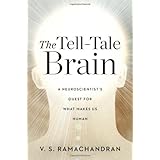
Average Reviews:

(More customer reviews)Are you looking to buy The Tell-Tale Brain: A Neuroscientist's Quest for What Makes Us Human? Here is the right place to find the great deals. we can offer discounts of up to 90% on The Tell-Tale Brain: A Neuroscientist's Quest for What Makes Us Human. Check out the link below:
>> Click Here to See Compare Prices and Get the Best Offers
The Tell-Tale Brain: A Neuroscientist's Quest for What Makes Us Human ReviewThe preeminent neuroscientist V.S. Ramachandran has, without a doubt, raised the bar in this, his newest book, The Tell-Tale Brain. He states in the preface, "Readers who have assiduously followed my whole oeuvre over the years will recognize some of the case histories that I presented in my previous books, Phantoms in the Brain: Probing the Mysteries of the Human Mind and A Brief Tour of Human Consciousness: From Impostor Poodles to Purple Numbers. These same readers will be pleased to see that I have new things to say about even my earlier findings and observations. Brain science has advanced at an astonishing pace over the past fifteen years, lending fresh perspectives on - well, just about everything. After decades of floundering in the shadow of the "hard" sciences, the age of neuroscience has truly dawned, and this rapid progress has directed and enriched my own work." And what an enriching book this is!In a nutshell, what Ramachandran does is to discover how the normal brain works by studying individuals with abnormal neurological conditions. In this respect, his books are similar to Oliver Sacks (The Man Who Mistook His Wife For A Hat: And Other Clinical Tales and The Mind's Eye). Some of the disorders Ramachandran discusses are: Agnosia, Anosognosia, Autism, Capgras Syndrome, Cotard Syndrome, and Synesthesia, to name a few. However, one of the finest things about Ramachandran's book is that this doesn't account for everything in the book; it's not simply Ramachandran rolling out one bizarre disorder after another. He hits the subject matter from every angle - anatomically, evolutionarily, psychologically, and philosophically. It's exceedingly evident that Ramachandran knows all of the topics - inside-and-out - in regards to mind, brain, and consciousness. And still, the writing was never over my head. It was just as Ramachandran said it would be, "I presume some degree of interest in science and curiosity about human nature, but I do not presume any sort of formal scientific background or even familiarity with my previous works. I hope this book proves instructive and inspiring to students of all levels and backgrounds, to colleagues in other disciplines, and to lay readers with no personal or professional stake in these topics."
Ramachandran states in the Epilogue, "One of the major themes in the book - whether talking about body image, mirror neurons, language evolution, or autism - has been the question of how your inner self interacts with the world (including the social world) while at the same time maintaining its privacy. The curious reciprocity between self and others is especially well developed in humans and probably exists only in rudimentary form in the great apes. I have suggested that many types of mental illness may result from derangements in this equilibrium. Understanding such disorders may pave the way not only for solving the abstract (or should I say philosophical) problem of the self at a theoretical level, but also for treating mental illness."
In conclusion, I strongly recommend reading this book. The writing is great, the style is flawless, and Ramachandran's self deprecating humor really keeps the material lively. Every issue in contemporary Mind/Brain/Consciousness literature has been addressed in one way or another and I think everyone would have something to gain from reading it. I would put this book right on par with Antonio Damasio's, Self Comes to Mind: Constructing the Conscious Brain, and Paul Nunez's, Brain, Mind, and the Structure of Reality. Along with V.S. Ramachandran, these men, each in his own way, is pointing the way for the entire Neuroscientific community..."The question of how neurons encode meaning and evoke all the semantic associations of an object is the holy grail of neuroscience, whether you are studying memory, perception, art, or consciousness." Ramachandran's book is not to be missed!The Tell-Tale Brain: A Neuroscientist's Quest for What Makes Us Human Overview
Want to learn more information about The Tell-Tale Brain: A Neuroscientist's Quest for What Makes Us Human?
>> Click Here to See All Customer Reviews & Ratings Now
0 comments:
Post a Comment